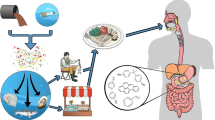Abstract.
Sydney rock oysters, Saccostrea commercialis, were deployed for a 3-month period at sewage-disturbed and control marine locations in the Hunter Region, New South Wales, Australia. After this period, the oysters were retrieved and the gills dissected and extracted for analysis of the saponified lipid components (including fatty acids and sterols), using gas chromatography-mass spectrometry (gc-ms). Multivariate analysis (discriminant function) of the gc-ms lipid profiles indicated that the lipid homeostasis in oysters from the sewage locations was significantly different compared with that observed in oysters from control locations (p < 0.0001). The primary factor discriminating between sewage and control locations was the level of β-sitosterol, a plant sterol derived from domestic sewage and marine algae. The results indicate that gill lipid metabolism differentially alters in response to deployment of oysters into either sewage-contaminated or control locations. This method of analysis provides a sensitive measure for the biological impact of composite waste cocktails on strategically located marker organisms in affected environments.
Similar content being viewed by others
Author information
Authors and Affiliations
Additional information
Received: 24 July 1997/Accepted: 3 January 1998
Rights and permissions
About this article
Cite this article
Avery, E., Dunstan, R. & Nell, J. The Use of Lipid Metabolic Profiling to Assess the Biological Impact of Marine Sewage Pollution. Arch. Environ. Contam. Toxicol. 35, 229–235 (1998). https://doi.org/10.1007/s002449900371
Issue Date:
DOI: https://doi.org/10.1007/s002449900371




